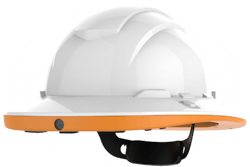I read a lot for both business and leisure, and sometimes the two combine. That happened not too long ago with a news magazine I was reading. It listed something called the smart hardhat and said it was one of the best inventions of 2020. Last June we discussed wearable technology in the “Working Remotely With Digital Technologies” article, so of course a smart hardhat (i.e., embedded sensors) got my attention.
Back in June, the focus was a GoPro attached to a hardhat brim or worn as a body cam. There was also a hardhat wired for augmented reality, but it turns out smart hardhats are a trending technology. This piece of personnel protective equipment (PPE) comes with a plethora of digital applications that can be designed to monitor whatever is needed by the wearer for their environment. They can be expensive depending on how they are configured.
Packed with Sensors
This next generation of headgear integrates IoT (Internet of Things) technology with head protection. It can have a heads-up visor display, built in wireless connectivity for multimedia options, sensors for proximity dangers, noise level monitoring, hazardous material detection, fall recognition, wearer’s location in three-dimensions, and more. The smarter hardhat provides a digital awareness of the wearer and the wearer’s surroundings.
As I read about the trend, my mind wandered off as it does from time to time, and I found myself thinking about my first hardhat. Some 40 plus years ago, I began my utility career as a substation engineer. The engineering department I worked in had about a dozen hardhats sitting by the coat rack at the front door. It was suggested we take one with us when we went out in the field, but it was a rarity to see anyone wearing a hardhat. Thank goodness that attitude changed quickly.
Over the years we all became more safety conscious and today it’s a totally different picture. Hardhats are equipped with safety glasses and hearing protection and we wear steel toed boots and fire retardant clothing. Now electronic devices have taken us to the next level with PPEs that include wearable IoT technologies to keep us safe in the field.
My first exposure to wearable sensors took place on a T&D World assignment to cover the Hurricane Ike restoration effort. I spent a week being embedded with different line crews each day. Crews came from utilities and contractors representing our industry from all over North America. They brought state-of-the-art materials and technologies from each of their home bases. Most were familiar and comfortable, but every now and then one of the line crews would toss out something that caused everyone to stand back and say whoa!
Battle Tested
That happened on the day I went with an out-of-state line crew into a wooded residential area north of north of Houston. As we talked and worked together, I saw a new accessory that I hadn’t seen before. It was a small black box attached to their belts. They told me it squawked whenever they were in close proximity with an energized object. It was a wearable voltage and current detector. As the day unfolded, it really proved its worth.
The area we were in had a lot of damage from blown down trees, which took the distribution lines and all the associated underbuilt cables with them. Adding to the restoration problems was the fact that many of those downed circuits were still energized. In other words, we had energized tree limbs, cars, sheds, puddles, metal fences – you name it. It was dangerous beyond belief, but the crews from this utility had an edge with their squealing devices.
The word soon got out and there was a steady stream of line crews stopping to talk about the device. They wanted to know where to get their own wearable detectors. Interestingly, the January 2021T&D World issue had a story about FirstEnergy using hardhat mounted voltage and current detectors for personnel protection. These hardhat mounted detectors provide audio and visual warnings, which is a big improvement to those early devices I saw years ago.
It is a huge advantage to have all this IoT connectivity built into a hat that is worn every day. It is also a plus to have applications and hardware built with field conditions in mind. Some folks are calling this the augmented human and I can’t wait to see where this trend is going!
About the Author
Gene Wolf
Technical Editor
Gene Wolf has been designing and building substations and other high technology facilities for over 32 years. He received his BSEE from Wichita State University. He received his MSEE from New Mexico State University. He is a registered professional engineer in the states of California and New Mexico. He started his career as a substation engineer for Kansas Gas and Electric, retired as the Principal Engineer of Stations for Public Service Company of New Mexico recently, and founded Lone Wolf Engineering, LLC an engineering consulting company.
Gene is widely recognized as a technical leader in the electric power industry. Gene is a fellow of the IEEE. He is the former Chairman of the IEEE PES T&D Committee. He has held the position of the Chairman of the HVDC & FACTS Subcommittee and membership in many T&D working groups. Gene is also active in renewable energy. He sponsored the formation of the “Integration of Renewable Energy into the Transmission & Distribution Grids” subcommittee and the “Intelligent Grid Transmission and Distribution” subcommittee within the Transmission and Distribution committee.
